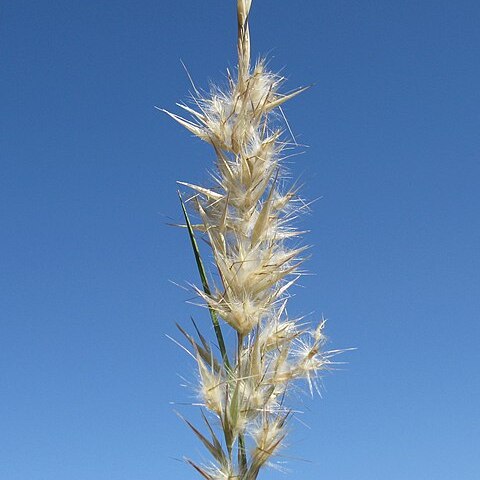Grey-green or greyish purple, coarse erect tussocks, occasionally shortly rhizomatous; leaves » culms; branching intra-and extravaginal. Leaf-sheath white or sometimes greyish, sometimes with few scattered fine hairs above; apical tuft of hairs 1-2-(3) mm. Ligule 0.1-0.4-(0.6) mm. Leaf-blade to 35 cm, flattish, becoming inrolled, to 3 mm wide, sometimes with scattered hairs, margins sparsely scabrid. Culm stout, to 1 m, internodes smooth, minutely scabrid below inflorescence. Panicle large, strict, to 15 cm, of many spikelets on ± rigid pedicels; rachis and pedicels closely short-scabrid, often longer hairs intermixed. Spikelets 5-6-(7)-flowered, awns included by or exserted from glumes. Glumes usually broad, purple-margined, lanceolate, subacute, (12)-15-17-(19) mm, ± equal, both 7-nerved. Lemma 2.5-3 mm, 9-nerved, upper and lower rows of hairs very dense, upper row < lemma lobes and much overlapped by lower, glabrous elsewhere, occasional hairs centrally and on margins; lobes (6.3)-7-9 mm, narrowed to fine awn; central awn (8.5)-10-14 mm, column 1-2.5 mm < upper lemma hairs. Palea 3.5-4.5 mm, < upper lemma hairs, interkeel hairs long, numerous, in lower ⅔, and on margins. Callus (0.8)-1-1.3 mm, marginal hair tufts overlapping lower lemma hairs. Rachilla c. 0.2 mm. Anthers 0.8-1.2 and 1.7-2.1 mm. Caryopsis 1.6-2 × 0.8 mm; embryo 0.7 mm; hilum 0.5 mm.
More
Plants caespitose; innovation buds intravaginal. Culms 23–80 cm high. Inflorescences linear-lanceolate to triangular. Spikelets 9–17 mm long, with 3–6 florets. Glumes substantially exceeding florets, green to straw-coloured, with purple margins; lower glume 7.5–17 mm long, 3–4 mm wide. Lemma: body 2–3.8 mm long, narrow, glabrous or villous between the rows of tufts; both rows of hair tufts complete, with lower row equalling or exceeding upper row; lobes longer than body, but not twice as long; setae 0.8–4 mm long, shorter than lobes; awn 6–14 mm long, exceeding setae; awn column tightly twisted, shorter than lobes and hidden in upper lemma hairs. Palea narrowly elliptic to ovate, 3–6 mm long, narrow, 3–5 times as long as wide, slightly exceeding lemma sinus, villous between keels, with lateral hair tufts. Anthers 1–2.1 mm long. Caryopsis 1.8–2.4 mm long.

